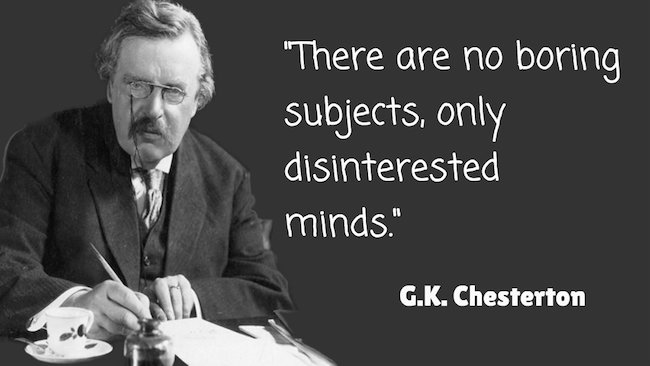Hey! Wake up!
Do you have to present on a boring topic?
Let’s do something about that!
The first thing you need to know is that your topic is fine!
Initially, almost all my client’s say that their subjects are boring, and other people have more interesting topics. Whether they are presenting about Marketing, Economics, Biotechnology, Big Data, Quality Assurance, Deep Learning Algorithms, or Sales, they always point outside to other fields and departments and say that others have more interesting topics.
If I buy into their premises, then there will be no interesting topics on this whole earth.
That’s why I share the belief of the English philosopher, G.K. Chesterton, that there are not any dull topics out there; there are only disinterested audiences.

That’s closer to the truth. So, instead of blaming your subject for being boring, you can start to look for ways to stir your audience’s interest (and awaken their minds.)
If your topic is not perceived as hot and sexy enough, then you need to speak about it with more confidence, authority, and conviction and soon people will be interested. Think about it like this: if Tobacco Companies sold smoking cigarettes as sexy, I am very sure you can sell your topic too.
Here are some ways to help you get your audience interested in your topic:
1- Start with why

How you start your presentation will determine if people listen to you or not. Two of the big questions your audience members have when they are in the room with you is “Why am I here?” “Why is this is important to me?”
If you don’t quickly tell them why they should care about the topic; then the audience will focus on other items they deem more important.
Simon Sink started a whole movement based on the idea that companies that explain the why of their product end up on top of the food chain. He stated in his famous Ted talk that the fundamental difference between the “Apples” of the world and everyone else is that Apple always starts with “why.”
Sinek based his idea on the fact that people are starving for meaning and relevance. I add that we live in a busy and noisy world, and your audience is careful with their time and attention. If you don’t show them the reason they should listen, then they will tune you out.
Now, starting with why does not mean that you forget about the why throughout the presentation. You have to keep connecting your topic to your audience’s interests throughout the talk.
Remember, your audience is always listening to one radio station: WIFM. What’s In it For Me. And to keep them interested in the topic, you have to keep tying your topic back to their interests.
2- Be interested in your topic

If you think your topic is boring, then how can you expect anyone else to like it when you present.
It’s impossible.
People will detect your lack of passion, disinterest, and insecurities about the topic. Your disinterest is like a virus that spreads and infects everyone around you.
Besides, even if you hint that your topic is boring, you will be missing out on an enormous influence phenomena: It’s called Social Curiosity Driver.

The Social Curiosity Driver tells us that if other people show interest in something in front of you, then we will get curious too.
Example, you are walking down the street, and you see ten people staring and pointing at the sky with amazed looks on their faces.
Would you be interested in finding out what they are looking at?
Of course, it’s human nature.
Now imagine leveraging that same phenomenon in your presentations.
Next time you present get interested in your topic and don’t fake it; just tap into real interest, and you will see how this will peak the curiosity of your audience. They will be sitting there, saying to themselves, “I don’t know what she sees in the topic, but there must be something interesting here.”
Social Curiosity Driver is a biologically hardwired phenomena. Don’t miss out on it.
Remember, if you can’t get yourself interested in what you are talking about, there is no way you will get your audience to be interested.
3- Let your personality shine through

Even, if you topic is boring – which is not.
Don’t be a boring person yourself.
Nearly every day, people ask you what you do for a living, you engage in conversation about your work, and maybe tell work-related anecdotes.
Sometimes our preconceived notions about how to put together and give a presentation can interfere with the important and simple goal of being interesting.
Don’t be constricted by a particular telling of the story on the slides. Be yourself. Interject anecdotes that support your talk. Add context with interesting “did you know” facts.Look your topic up on Wikipedia, and you might find out something you never knew before.
For example, if you’re talking about cash vs. accrual accounting, did you know that U.S. tax authorities started accepting accrual methods in 1916? That means 2016 is the 100th anniversary of accrual! Pretty exciting stuff! I am not in accounting, and I find that fascinating as an entrepreneur.
Your topic is not boring, and you are not boring.
Personal Confession:
Somehow, when I was an engineer, I bought into the misleading cultural premise that engineers are not exciting; that they are boring people. Honestly, I bought into it because it allowed me to be lazy and not have to try too hard to make my topic interesting to my audience.
Please don’t make the same mistake. Whatever you do for a living can be fascinating. You just have to put some effort into it.
Nowadays, I work with so many professionals, directors, and C-level executives from many industries, and when I see them put just a little bit of effort, they turn into superstar presenters and the go to people in their organization to represent the whole company.
4- There is no such thing as a boring topic, only boring angles

When you talk to reporters, they always use the word “angle.” The angle is how you approach and present about a subject. Reporters know the power of the angle, and that’s how they get you interested in reading their stories.
So instead of complaining about your boring topic, think, what angle should I use to get people interested in this topic.
A computer science client of mine was presenting in front of neuroscientists. Instead of jumping into his algorithms right away, he started talking about some problems neuroscientists are facing and then presented his work as a possible interesting solution to those problems. The audience was riveted instead of bored to death with algorithms. That’s an example of a good angle.
Let’s say for example your topic is doodling. Or what happens when you encounter a broken web page and get a “404” error message. Hard to imagine less interesting subjects isn’t it? Somehow “Doodlers Unite” and “404, The Story of a Page Not Found” are among a list of the 22 best TED Talks ever!
That’s an example of how Renny Gleeson found a great angle to present on the topic of 404 error messages.
TED Talks can be great examples of making any subject interesting.
Sure, many TED speakers speak on what we might think of as interesting topics like business, information technology, and public policy.
But there are hundreds and hundreds of speakers who give interesting talks on how to be a better grocery shopper, how painting a house led to a better community, and the physics of pizza.
Notice that all good Ted talks have good angles.
5- Break up the flow of the presentation
Maybe your presentation topic requires information dense, flat and “uninteresting” (or difficult to absorb) slides. One way to make this type of presentation more interesting is to break up the flow.
At appropriate points in the story, you could stop, insert an audience poll, a video, a graphic of a recent news item, or a quote relevant to the topic.
Some free or inexpensive audience polling tools work well with PowerPoint, such as Poll Everywhere, and ParticiPoll. The Tech Republic has some suggestions on others.
If a poll is not appropriate, you can utilize a variety of interactive games to make your presentation more interesting. Use interactive techniques that work with your personality.
6- Include something entirely irrelevant in your presentation

Can you guess what the image above means?
It means nothing 🙂 Just wanted to add a break to demonstrate the point below:
If your audience has a sense of humor and the occasion is appropriate, some speakers like to break up a presentation by inserting something entirely irrelevant to re-engage the audience.
For example, if the time of year/timing is right you could pick one of your favorite holiday photos and put it on the slide and speak to it. Some people add a photo of their family or a picture of their car. You could even acknowledge, “Hey I know this material is a little demanding so I thought we’d take a break and talk about Thanksgiving dinner. Ir will be a quick break to help you digest the material better.”
In the Science of Influence, this is called, “breaking state.” If people get in a bored state, the best way to get them out of it is to break that state. One of the best ways to do so is to do something completely off topic.
While this does briefly interrupt your story, it can be an effective way to rekindle the participation of audience members who may have started checking email or are otherwise losing their focus on your presentation.
It’s a great technique especially late in the afternoon when people are sleepy from lunch.
Always give a reason for the break, or when you talk about irrelevant things, otherwise, some of your audience will think you are wasting their time.
Here are some examples of reasons you can use for introducing something irrelevant to the topic:
1- “Just to give you a little break from the material, I wanted to ….”
2- “To help you compartmentalize the previous information and separate it from the rest of the talk, I would like to introduce a quick visual break….”
3- “Just to break this dense material up a little bit, I wanted to give a quick break…”
4- etc.
7- Take a different approach to slide design
You can make a “seemingly” flat topic more lively by taking an innovative approach to slide design.
Who doesn’t have a hard time looking at spreadsheets and bullet points for 45 minutes or an hour? What if instead, you use a historical theme for your presentation, supporting it with memorable images from the past that help supports your speaking point?
If you want to consider using images from the past, the National History Education Clearinghouse offers some great resources for finding memorable images online. And of course, there’s ever faithful Google Image Search. But with all of these, you’ll want to consider copyright implications if you give your presentation publicly or publish it.
You can even change up the color palette of your theme. The popularity of various colors has changed over the years. Here’s a blog post on historical color themes you can use to give your presentation a retro look that might fit the story you’re trying to tell. Don’t settle for the generic templates all the people in your department use. Think outside the box and use more interesting templates.
It’s a general rule of presentation design that form follows function. In other words, the data you are presenting and the concepts that you’re trying to get across are more important than the graphics. But you can use an unusual graphical concept if it does not interfere with getting your message across, and it can help give your presentation some variety and make it more interesting to your audience.
8- Offer people an Easter egg

Easter eggs are something children hunt for on Easter. But it’s also a term from the world of movies. An Easter egg is a little something the director or producer has hidden in the scene with perhaps secret or additional meaning. You could put one or more Easter eggs in your presentation.
Let me explain how you would do that. Let’s continue with the accounting example. You could start your presentation by telling people that there are three references to famous economists hidden throughout your presentation, and at the end of your talk, you’ll ask your audience if anyone found all three.
If you’re an author, you can even offer a free copy of your book to the first person to correctly identify all three references. You’d be surprised at how closely people pay attention when they are challenged to be competitive.
9- Create the illusion of a conversation to hook your audience

Your audience doesn’t want you to “speak at” them. They want you to engage them in a conversation. Since the presentation format is restrictive, you sometimes have to create the illusion of a conversation.
The best way to do that is to use rhetorical questions. These are questions that you ask and then answer on stage. Rhetorical questions create the illusion of dialog when presenting and instinctively interest your audience.
Here is a formula to use when applying rhetorical questions:
1- Make a point
2- Ask a question about the point
3 – Answer
Here is an example that I use:
1- Make a point: Public Speaking is hard.
2- Ask a question about the point: So why is public speaking hard?
3 – Answer: The answer is not because we are stupid. It’s because we are conditioned all our lives to think that it’s hard. Since childhood, we have been conditioned not to speak up in class, not to challenge authority and not to make eye contact with strangers.
And after all, that, as adults we are expected to drop years of conditioning, stand up, make eye contact, and speak up to give presentations in front of groups of strangers.
Using rhetorical questions along with open ended and closed ended questions will turn your topic into an engaging presentation. When your audience feels that they are active participants in your presentation they will get a sense of ownership in the topic and that alone will keep them interested.
Conclusion:
How to Make a “Boring Topic” Interesting? Leverage available tools and practices to interest people in your topic. After all, there are no boring subjects only disinterested minds. Figure out how to re-interest those minds and you can become a fascinating person in your peer group at work.



